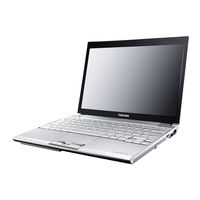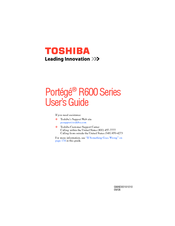Toshiba Portege R600 Manuals
Manuals and User Guides for Toshiba Portege R600. We have 7 Toshiba Portege R600 manuals available for free PDF download: Maintenance Manual, Manual Del Usuario, User Manual, Specification Sheet
Toshiba Portege R600 Maintenance Manual (410 pages)
Maintenance Manual
Table of Contents
-
-
-
-
Features15
-
-
LCD Module34
-
-
Power Supply35
-
Setup39
-
-
Figures45
-
Figure45
-
Tables45
-
-
Troubleshooting107
-
-
-
Heatrun Test135
-
Subtest Names136
-
System Test138
-
Memory Test140
-
Keyboard Test141
-
Display Test142
-
Floppy Disk Test145
-
Printer Test147
-
Async Test149
-
Hard Disk Test150
-
Real Timer Test153
-
NDP Test155
-
Expansion Test156
-
Only One Test164
-
Head Cleaning175
-
Log Utilities176
-
Running Test178
-
-
Lan Test197
-
Modem Test200
-
Ieee1394 Test203
-
-
Test Program204
-
Setup205
-
-
-
Overview229
-
Battery Pack238
-
Sim Card240
-
Memory Module243
-
Base Assembly246
-
Expresscard Slot249
-
Battery Lock251
-
Rtc Battery262
-
Cooling Module264
-
DC-In Harness266
-
Bluetooth Module272
-
System Board276
-
-
Keyboard290
-
-
Camera Module295
-
Appendices317
-
Advertisement
Toshiba Portege R600 User Manual (247 pages)
R600-S4201 User's Guide
Table of Contents
-
Introduction36
-
This Guide38
-
Safety Icons39
-
-
-
-
-
Battery Notice107
-
Power Management109
-
-
Traveling Tips123
-
-
Web Camera132
Toshiba Portege R600 User Manual (235 pages)
PORTEGE
Table of Contents
-
Conventions22
-
Preface22
-
Heat Injury26
-
-
-
Left Side44
-
Right Side46
-
Back49
-
Underside50
-
Indicators56
-
AC Adaptor61
-
-
Hardware62
-
-
-
Web Camera104
-
-
Loading Discs109
-
Removing Discs111
-
-
Media Care126
-
Floppy Diskettes126
-
Sound System127
-
Modem129
-
Properties Menu130
-
Modem Selection131
-
-
Lan136
-
Hdd Protection140
-
Heat Dispersal143
-
-
Typewriter Keys144
-
Hot Keys146
-
Fn Sticky Key148
-
Keypad Overlay149
-
Arrow Mode149
-
-
-
Power Conditions151
-
Battery154
-
Power-Up Modes164
-
Advertisement
Toshiba Portege R600 User Manual (219 pages)
Toshiba Portege A600-S2201: User Guide
Table of Contents
-
-
-
Sleep Mode25
-
-
Left Side34
-
Right Side36
-
Back38
-
Underside39
-
Indicators45
-
AC Adaptor50
-
-
Hardware52
-
-
-
Web Camera92
-
-
Media Care112
-
Floppy Diskettes113
-
Sound System114
-
Modem116
-
Region Selection116
-
Properties Menu117
-
Modem Selection117
-
-
Lan123
-
Hdd Protection127
-
Heat Dispersal130
-
-
Typewriter Keys131
-
Hot Keys133
-
Keypad Overlay136
-
Arrow Mode136
-
-
-
Power Conditions138
-
Battery140
-
DC in Indicator140
-
Power-Up Modes150
-
-
-
HW Setup Window151
-
Boot Priority152
-
Device Config156
-
-
-
-
Self Test160
-
-
Ac Power161
-
Real Time Clock163
-
Hard Disk Drive164
-
-
Pointing Device168
-
Touch Pad168
-
Usb Mouse169
-
Esata Device173
-
TOSHIBA Support178
-
Specifications179
-
-
Wireless LAN182
-
-
-
Cpu*2196
-
Battery Life*4197
-
Lcd*6198
-
Wireless LAN*8198
-
Toshiba Portege R600 User Manual (218 pages)
User Manual
Table of Contents
-
-
-
Sleep Mode28
-
-
Left Side38
-
Right Side40
-
Back42
-
Underside43
-
-
Indicators49
-
AC Adaptor54
-
-
-
Web Camera95
-
-
Loading Discs100
-
Removing Discs102
-
-
Media Care115
-
Floppy Diskettes116
-
Sound System117
-
Power Management118
-
Radio Links121
-
Product Support122
-
Lan123
-
Lan Cable Types123
-
Hdd Protection127
-
Heat Dispersal130
-
-
-
Typewriter Keys131
-
Hot Keys133
-
Keypad Overlay136
-
Arrow Mode136
-
-
-
Power Conditions138
-
Battery140
-
Power-Up Modes150
-
-
-
HW Setup Window151
-
Boot Priority152
-
Device Config156
-
-
-
Ac Power162
-
Real Time Clock164
-
Hard Disk Drive165
-
Pointing Device168
-
Touch Pad168
-
Usb Mouse169
-
Esata Device173
-
-
Wireless Lan177
-
TOSHIBA Support178
-
Specifications179
-
-
Wireless LAN182
-
-
-
Cpu196
-
Battery Life197
-
Lcd198
-
Wireless LAN198
-
Copy Protection199
-
Toshiba Portege R600 Specification Sheet (1 page)
OraclespecsheetR600.pdf
(Spanish) Toshiba Portege R600 Manual Del Usuario (259 pages)
User's Guide for Portege R600 series (Spanish) (Español)
Table of Contents
-
Introducción39
-
Este Manual41
-
-
-
-
-
Computadora119
-
-
-
Cámara Web127
-
-
-
Conexión136
-
Seguridad137
-
Optimización139
-
-
Utilidad Ratón151
-
Configfree166
-
Advertisement






